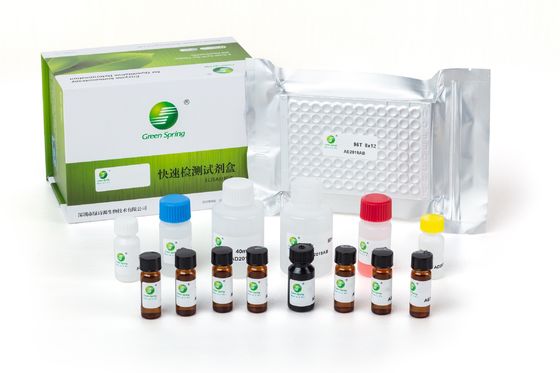|
|
LSY-10063 Nicarbazine ELISA Test Kit for feed
|
Product Details:
Payment & Shipping Terms:
|
| Properties: | Diagnosis & Injection | Specifications: | 96 Wells/kit |
|---|---|---|---|
| Sensitivity: | 0.1 Ppb | Incubation Time: | 30min~15min |
| Sampleperformance: | Tissue, Feed | Shelf Life: | 12 Months When Properly Stored |
| Incubator Temperature: | 25℃ |
Nicarbazine ELISA Test Kit
Catalog No. LSY-10063
1. Principle
This test kit is based on the indirect competitive enzyme immunoassay for the detection of Nicarbazine. The coupling antigen is pre-coated on the micro-well stripes. The Nicarbazine in the sample and the coupling antigens pre-coated on the micro-well stripes compete for the anti- Nicarbazine antibodies. After the addition of the enzyme conjugate, the TMB substrate is added for coloration. The optical density (OD) value of the sample has a negative correlation with the Nicarbazine in the sample. This value is compared to the standard curve and the Nicarbazine residues is subsequently obtained.
2. Technical specifications
Sensitivity: 0.1 ppb
Incubator temperature: 25℃
Incubator time: 30min~15min
Detection limit:
Tissue……………………………...….10ppb
Feed……………………………...…....20ppb
Cross-reaction rate:
Nicarbazine ..........................................100%
Recovery rate:
Tissue, Feed………………………70%-120%
- Components
| 1 | Micro-well strips | 12 strips with 8 removable wells each | |
| 2 | 6× standard solution (1 mL each) | 0ppb | 0.1ppb |
| 0.3ppb | 0.9ppb | ||
| 2.7ppb | 8.1ppb | ||
| 3 | Enzyme conjugate | 7ml | red cap |
| 4 | Antibody working solution | 7ml | blue cap |
| 5 | Substrate A | 7ml | white cap |
| 6 | Substrate B | 7ml | black cap |
| 7 | Stop solution | 7ml | yellow cap |
| 8 | 20× concentrated washing buffer | 15ml | white cap |
| 9 | Sample dilution | 50ml*2 | transparent cap |
4. Materials required but not provided
1) Equipment: ELISA Reader (450 nm/630nm), homogenizer, shaker, centrifuge, balance: 0.01g quantity sensitive, incubator, graduated pipettes, printer
2) Micropipettes: single-channel 20ml ~ 200ml, 100ml ~ 1000ml, multi-channel 30~300 μl
3) Reagents: Acetonitrile.
- Sample pre-treatment
Instructions (The following points must be dealt with before the pre-treatment)
- Only the disposable tips can be used for the experiments and the tips must be changed when used for absorbing different reagents;
2) Before the experiment, each experimental utensil must be clean and should be re-cleaned if necessary, in order to avoid the contamination that interferes with the experimental results.
Samples Preparation
- Preparation of Tissue sample
- Take 1.0±0.05g tissue sample into 10ml centrifuge tube, add 2ml acetonitrile, vortex for 5min;
- Centrifuge at above 4000r/min at room temperature(20℃-25℃) for 5 min;
- Take 50ul supernatant, add 950ul Sample dilution, shake violently to mix for 30s;
- Take 50μl to test.
Dilution factor: 40
- Preparation of Feed sample
- Take 5.0±0.05g feed sample into 50ml centrifuge tube; add 20ml acetonitrile, then vortex for 5min;
- Centrifuge at above 4000r/min at room temperature(20℃-25℃) for 5min;
- Take 50ul supernatant, add 950ul Sample dilution, shake violently to mix for 30s;
- Take 50μl to test.
Dilution factor: 80
![]()
elisa kit
-
LSY-10049 Chlortetracyline ELISA test kit Antibiotic detection
-
LSY-10050 Erythromycin ELISA test kit for milk, honey, tissue
-
LSY-10046 MQCA Olaquindox metabolites ELISA Test Kit ISO certificated
-
LSY-10047 Nitroimidazoles ELISA Test Kit for tissue, honey, milk and egg
-
LSY-10047 Nitromidazoly ELISA Test Kit antibiotic residue Food safety
-
LSY-10047 Nitromidazoly ELISA Test Kit Food testing ISO certificated



